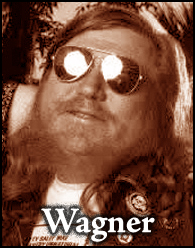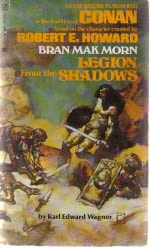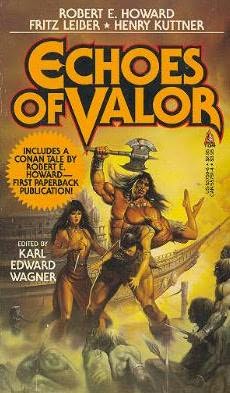Reflections Upon Karl Edward Wagner, Fifteen Years Gone
Tuesday, October 13, 2009
posted by Deuce Richardson
 Print This Post
Print This Post

Karl Edward Wagner (1945 -1994) died fifteen years ago today. I never knew Karl. Nevertheless, his work as an author, essayist, editor and REH scholar has affected my views regarding the entire field of weird literature since I was barely a teenager. I believe that he should be remembered and due attention paid.
I first discovered KEW’s work by way of Robert E. Howard. Having just read the Zebra edition of Worms of the Earth, I wanted more Bran Mak Morn. Learning of Wagner’s BMM pastiche, Legion From the Shadows, I tracked it down.
Legion From the Shadows has always gotten mixed reviews. Don Herron (like Wagner, a Tennessean) is on record as stating that KEW’s Bran was a bit too prone to concussions to be credible as a Howardian protagonist, likening Karl’s Pict to the glass-skulled heroes of Hugh B. Cave’s tales. Others have pointed out weaknesses in plot and motivation, specifically in regard to the enigmatic Liuba.

All these points may be valid, but I contend that Wagner maintained an atmosphere of grim, desperate horror and menace in Legion From the Shadows that makes the novel one of the few Howardian pastiches worth reading. It also had another thing going for it in my eyes: the dedication and afterword. The dedication was to David Drake and the afterword discussed the seminal horror author (hitherto unbeknownst to me, outside of the citation in “The Children of the Night“), Arthur Machen. Both dedication and afterword were emblematic of Wagner’s life-long practice of heralding new talent and also being a loremaster of weird tales past.
Within a few months I’d found a copy of the Lin Carter-edited, The Year’s Best Fantasy Stories: 3. Within was “Two Suns Setting,” featuring Wagner’s immortal hero-villain, Kane. As Steve Tompkins noted, that tale is a categorically American and Howardian one. It immediately won me over to KEW’s most famous creation. It probably didn’t hurt that the story showed Kane at his most likeable and sympathetic.

Over the next few years, despite diligent searching, I only managed to acquire Bloodstone and Dark Crusade. All of this in spite of the fact that the early 1980s were probably the heyday of Wagner’s books being in print/available. It is a perennial gripe amongst Wagner fans (and potential ones) that Karl’s works are hard to find. Apparently, much like REH’s works (though, perhaps, to a lesser extent), KEW’s books tend to remain in the possession of their readers and not be recycled back to bookstores and ebay.
The years from 1987 to 1991 were when I acquired the majority of the books in my Karl Edward Wagner collection. I had greater access to bookstores and more funds at my disposal, of which I took full advantage. I remember one visit to a bookstore accompanied by a friend who was also a KEW fan. Somehow, he chanced to find a pristine copy of Night Winds before I did. He chortled at my dismay. Later that evening, before we headed to the bars, he handed the book to me and told me to keep it. A few years later, I handed him an edition of The Book of Kane, published by Donald M. Grant, for Christmas.
During that same period, I branched out from reading Karl’s contributions to the realm of fantasy and began searching for his work in the horror field, both as an author and an editor. Reading Wagner’s “Sticks” (reviewed more fully here on TC by [redacted]) ignited that search. My finding copies of In a Lonely Place and Why Not You and I? were personal triumphs. Wagner was editor for DAW’s popular “The Year’s Best Horror Stories” for fifteen years, so finding volumes from that series was not particularly hard. Always (or near enough), Wagner’s selections and introductions were worth reading. Horror lit has ever taken a bit of a backseat for me in comparison to fantasy, so I can safely say that without KEW’s editorial work, my knowledge of the field (past and present) would be markedly lessened. I still firmly believe that Peter Straub should have included a Wagner story in the second volume of American Fantastic Tales.
 Also during that period, Karl got TOR Books to green-light the “Echoes of Valor” series, which featured heroic fantasy fiction from the glory days of pulp. Getting those tales back in print was a service to fantasy literature, and one that should not be forgotten. Wagner’s knowledgeable introductions will definitely fuel/inspire some future blogs from yours truly.
Also during that period, Karl got TOR Books to green-light the “Echoes of Valor” series, which featured heroic fantasy fiction from the glory days of pulp. Getting those tales back in print was a service to fantasy literature, and one that should not be forgotten. Wagner’s knowledgeable introductions will definitely fuel/inspire some future blogs from yours truly.
Somehow, I never picked up the first volume of the series until after I bought The Fantastic Worlds of Robert E. Howard. Reading that collection of essays from the sequestered mailings of REHupa, I discovered the fact that Wagner had printed “The Black Stranger” within the pages of Echoes of Valor (the initial volume in the series) for the first time. The first time ever. I was quickly apprised of the fact that “The Black Stranger” was a far different beast than the double-reverse-engineered monstrosity L. Sprague de Camp had entitled “The Treasure of Tranicos.” Not only that, but KEW had blown the whistle on Howardian post-mortem “Conantics” before anyone else in his forewords and afterwords composed for the Berkley Conan series. Learning this, I quickly purchased all three Berkleys; all that LSdC allowed to see print before he stifled the rest in their cradle.
Not too long after I learned all that, the most significant event in the twenty-first century history of Wagner’s published works occurred: Night Shade Books released Midnight Sun and Gods in Darkness. Those two high-quality, hardbound volumes collected all of KEW’s Kane stories and novels between four covers. They quickly sold out, and copies now appear on ebay for triple-digit figures. One has to wonder why no new editions of Karl’s work have seen print since; a question only the Wagner estate can answer.
Around the same time that the Night Shade volumes were published, I acquired The New Lovecraft Circle edited by Robert M. Price. Within its pages lay “I’ve Come to Talk With You Again.” That story, by general concensus, was the last that Karl ever wrote. It is suffused with a quiet nihilism that is explicity linked to Chambers’ The King in Yellow. The protagonist, Kent Allard, seems to have been to Wagner what Randolph Carter was to Lovecraft. After reading it, I experienced a feeling much like that when I read Howard’s “Nekht Semerkeht.” This was a story written by one who knew he was not long for this world.
Fifteen years after his untimely demise, Karl Edward Wagner is not a dark prophet wholly without honor in his hometown of Knoxville, Tennessee. Spearheaded by his family and friends, a memorial and celebratory festival devoted to KEW’s legacy will be held in Knoxville on October 17th.
Steve Tompkins was a tireless proselytizer of Wagner’s works. Rereading one of his posts devoted to KEW was what prompted me to write this memorial essay.
